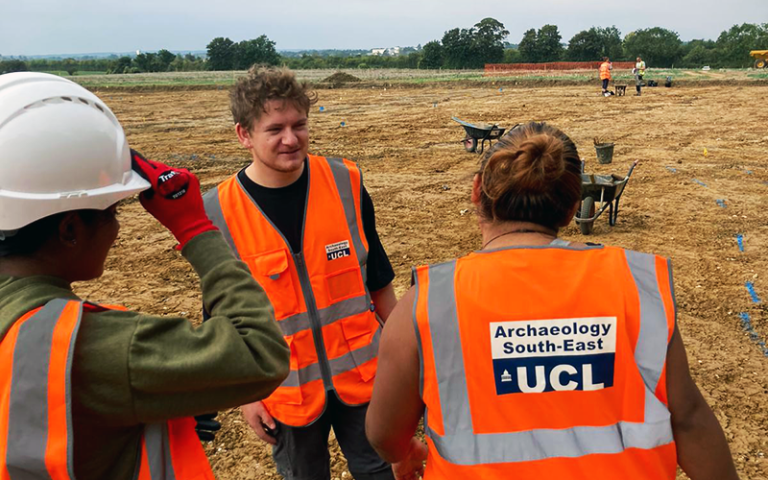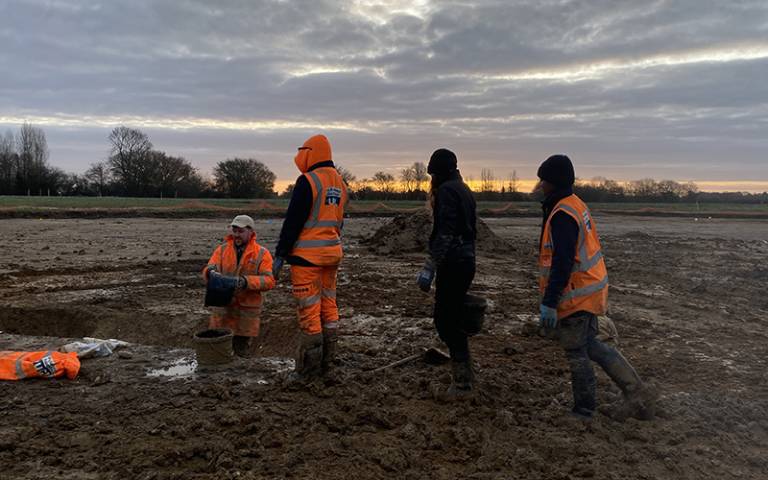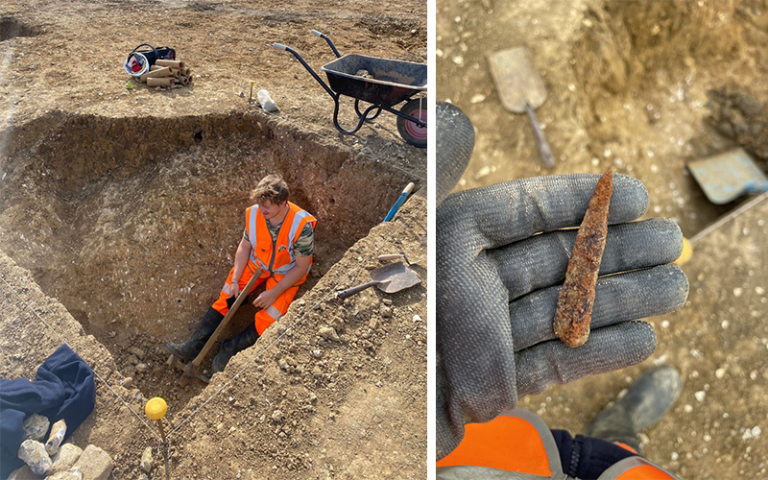Four months excavating with ASE: Placement students reflect
18 January 2024
Catch up with ASE’s Institute of Archaeology placement students who have spent much of the last four months with our field team excavating archaeological sites.

Claire, Galahad, Sol and Tasnima have been out on site since starting the placement part of their BA Archaeology with Placement Year in September, getting essential excavation experience with ASE’s field archaeologists. As they start a phase of working in post-excavation they’ve been reflecting on their achievements and challenges out on site.
A day in the life
What have the last few months looked like for our students? Although no two days on an archaeological site are quite the same, things tended to follow a similar pattern. Each day began with an early start, which (unsurprisingly) our students weren’t massive fans of and took some getting used to! Upon getting to site at 8am the team often had to work together to bail out water that had gathered in features overnight. The students would then begin working individually on their assigned features, which could vary from large 2m ditch slots all the way to pits and post holes. Some might work on certain large or complex features for several days, whereas others might work on multiple smaller features a day. Once the features were finished being excavated, they needed to be recorded, including assigning context numbers, bagging finds, filling out context sheets, taking photographs, and drawing plans and sections.

Winter mornings often began with some serious teamwork to bail out wet features.
Favourite features
Each of our students dug many many features over their time on site, but there were some that stood out.
Tasnima’s favourite feature was a small ditch slot, which contained interesting archaeology. “It consisted of two fills, with the basal fill being very dark and consisting of large pot sherds, some of which fit together. There was more pot in the top fill, along with snail shells, and an abundance of oyster shells in the basal fill.”
Sol was initially daunted by his stand out feature. “Initially, when the site officer took me over to an enclosure ditch to assign me a large feature, I wasn’t sure I’d be capable. Measuring at about 5m wide, and eventually, 1.2m deep, the ditch slot consisted of a unique fill, and pottery types that had not yet been found on site. It took about a week to dig and record in poor conditions. Each morning I had to bail water out and throughout the days I was constantly battling against intrusive ground water. Excavating this feature is an achievement that I’ll always associate with my time at ASE. It was definitely a character-building exercise!”

Sol takes a well-deserved break!
While working on excavating features associated with an Iron Age roundhouse, Claire made an exciting discovery. “I found a large pot sherd just under the surface. It was a rim which underneath had little impressions assumingly from two fingers that pressed into the clay creating a dotted pattern on the surface. It reminded me how special it was to find objects created and touched by others in the past.”
Galahad’s most memorable feature yielded some interesting archaeological finds. “My best discovery would probably have to have been a large round pit I dug that culminated with an animal skull right at the very bottom. Excavating towards the bottom of this pit also brought me my first iron find, rusted beyond any reasonable recognition from me.”

Galahad on site (left) and his first iron find (right).
Achievements and challenges

Claire making the best of a muddy situation!
Claire, Tasnima and Galahad all enjoyed cleaning sections and features once digging was complete. Claire says, “There is something quite satisfying with cleaning up what you’ve done and seeing it clearly for the first time”, and Galahad says, “This can be even more satisfying on large features that have taken a considerable amount of time”. Sol says, “The whole process of digging and recording a feature is really fulfilling, especially when it’s taken a while to dig. When you’ve spent a week or so in a muddy hole, you develop a level of attachment to the feature you’re digging and therefore take the utmost pride in your work throughout the recording stages.”
All of the students understandably found the wet weather difficult. Bailing water out of features was a task that Galahad loved to hate – “it’s quite a monotonous task but it’s a good one to start with as it wakes you up!”. Tasnima found that “On particularly wet days (of which there were many!), I spent a fair amount of time cleaning tools or wheelbarrow wheels to continue digging properly.” And Claire remembers making sure to leave her trowel somewhere clear at the end of the day, or risk losing it in a sea of mud! Through these trying times, Sol says “I have definitely developed a sense of invincibility, if I can excavate in those conditions, then I’ll be fine wherever I go.”
Excavation is obviously an incredibly physical activity and it took some time for the students’ bodies to adapt. Claire says, “It took some time for my muscles to get used to the job which meant a lot of stretching and pacing myself. Once I got into the rhythm and settled down, the job was more enjoyable.” Tasnima says, “I didn’t expect to end up with broader shoulders so quickly, or with the pronounced ‘Troweller’s muscle’ in my hand!”

Tasnima making the most of her new muscles excavating on site
What’s next for our students?
Although they'll be back out on site in the future, no doubt our team of four will be pleased to leave winter fieldwork behind as they start the post-excavation phase of their placement. For the next few months they will be processing finds and environmental samples, and working with our Drawing Office to digitise site drawings. Hopefully some of these they might have collected or recorded themselves out on site! These form just some of the initial tasks they’ll be undertaking, all of which aim to show how the highly technical excavation and recording undertaken by our field team is cleaned, processed and digitised for the next phase of analysis.
For more information on the degree our placement students are studying for, check out the BA Archaeology with Placement Year prospectus page. You can find more student testimonials over on the Placement Student Hub.
 Close
Close

